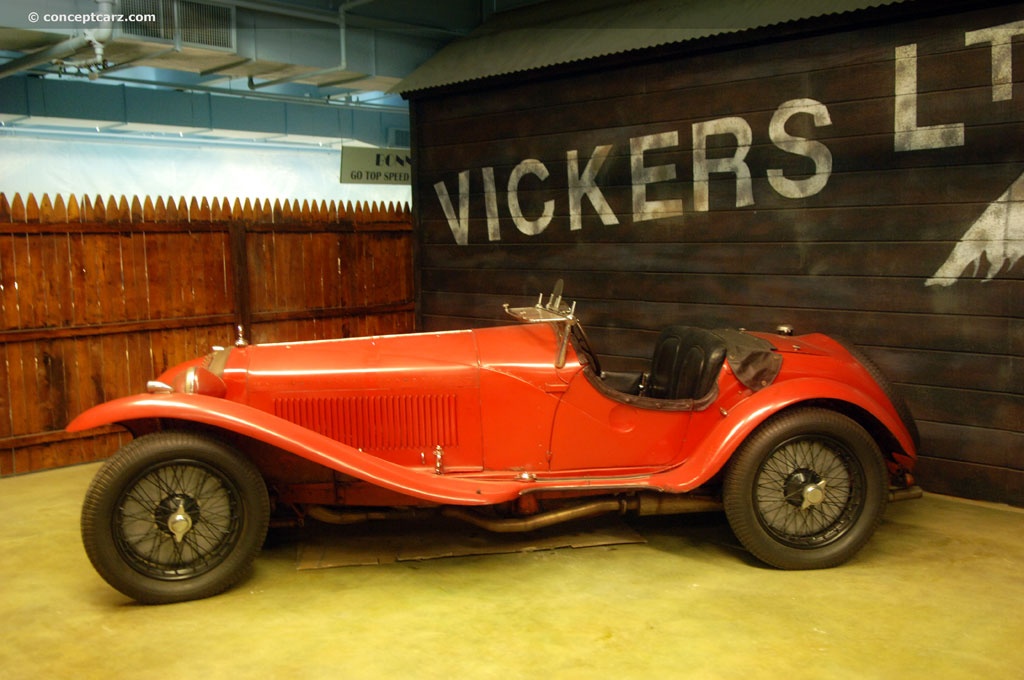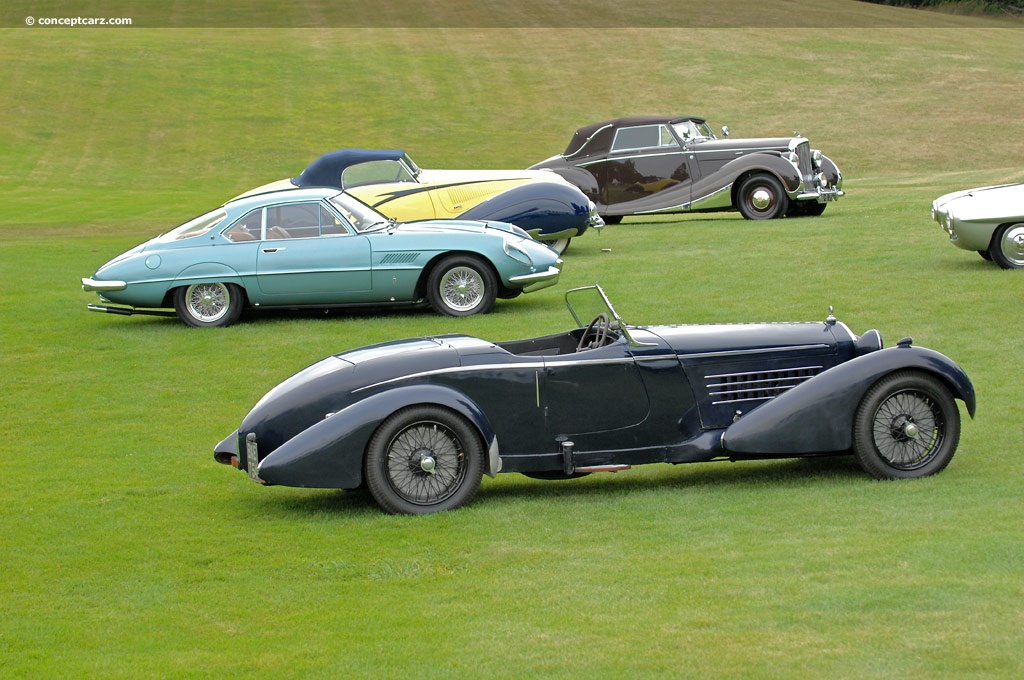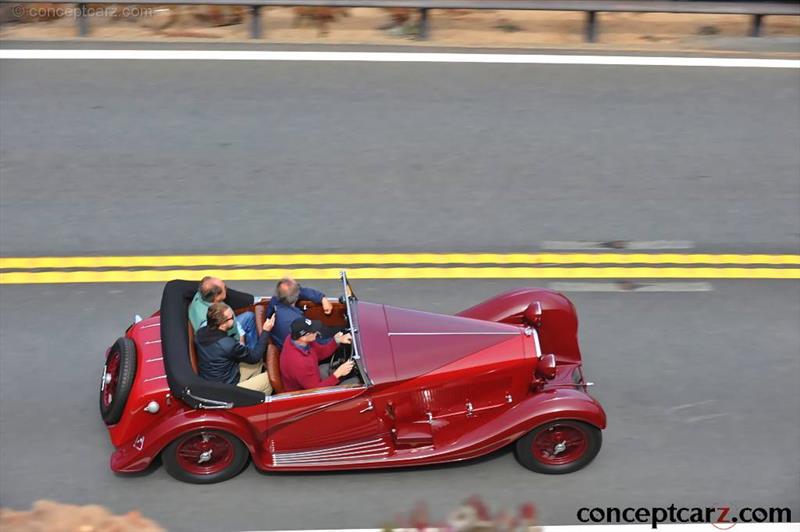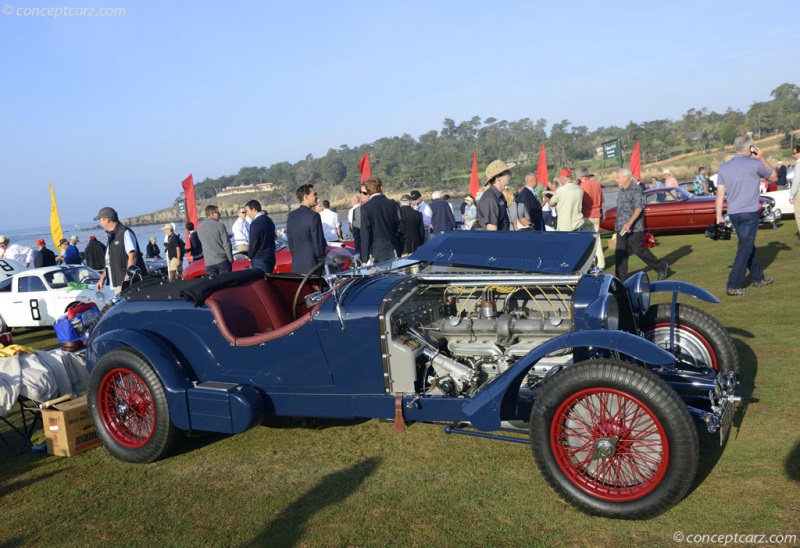The Alfa Romeo 8C 2300 was introduced in 1931 as the company's first eight-cylinder road car and the successor to the 6C 1750. Alfa Romeo had used a straight-eight-cylinder engine since 1924 to power the 1987cc P2, featuring a common crankcase and four plated-steel two-cylinder blocks. Despite being an eight-cylinder Alfa, it did not use the 8C designation. Nevertheless, it helped Alfa Romeo earn its first World Championship ever in 1925.
Spider by CastagnaThe 8C of the 1930s was also designed by engineer Vittorio Jano. It was a high-performance automobile capable of sustained full-throttle performance on high-speed roads and allowed Alfa Romeo to remain at the forefront of international motor racing. During the early 1930s, the 8C won the 24 Hours of Le Mans on four occasions with drivers Luigi Chinetti, Tazio Nuvolari, and Raymond Sommer. Jano essentially arranged two four-cylinder units in tandem with the cam-drive gears amidship creating a straight-eight engine with twin overhead camshafts. The 2,336cc unit had a bore and stroke of 66 x 88 mm respectively, while the twin-lobe Roots-type supercharger was driven at 1.33-times crankshaft speed. The bore and stroke were the same measurements as the 6C 1750, as were the rods and pistons. The engine was backed by a four-speed manual gearbox and drum brakes at all four corners provided the stopping power. The short wheelbase measured 2.75 meters and was known as the Corto (short) chassis while the longer versions were 3.1 meters and dubbed the Lungo. With over 140 horsepower at 5,000 RPM, the 8C was a genuine 100 mph automobile.Alfa Romeo initially announced that the 8C would not be sold to privateers, but by autumn of that year, it was sold as a rolling chassis. These chassis were clothed with bodies from various Italian coachbuilders including Pinin Farina, Brianza, Zagato, Touring, and Castagna. Other examples wore coachwork by Graber, Worblaufen, and Tuscher of Switzerland and Figoni of France.
Spider by CastagnaThe 8C engine first appeared in 1931 at the Mille Miglia road race through Italy where two examples wore Zagato coachwork with one being driven by Tazio Nuvolari and the other by Luigi Arcangeli. Unfortunately, both were plagued by tire problems throughout the race with the Nuvolari car crashing near the end. A few weeks later, Nuvolari drove the 8C 2300 to its first major victory at the rain-soaked Targa Florio, the first of three consecutive victories (Nuvolari won in 1931 and 1932 with an 8C 2300 Monza. Antonio Brivio won in 1933 with an 8C 2300 Monza). The Tipo A and the 8C 2300 were entered in the Italian Grand Prix at Monza on May 25th, unfortunately, during practice, the Tipo A suffered a fatal accident with Arcangeli behind the wheel. After two hours of racing, Nuvolari abandoned his Tipo A for an 8C 2300, and together with Giuseppe Campari, he won the race. The proceeding Grand Prix 8C 2300s constructed was labeled as the Monza in recognition of the victory. After the Italian Grand Prix came the 24 Hours of LeMans. Alfa Romeo entered three long chassis examples with aluminum coachwork by Zagato. The additional space was used to accommodate racing regulations dictating four-seater coachwork. Of the three cars, only two were entered in the race, one by the works team, and the other was a British entry. The third example blew its engine during practice and was unable to compete. During the race, the Works Alfa crashed out after 99 laps. The British entered Alfa was driven by Lord Howe and Tim Birkin finished the race well ahead of the next competitor, earning the first of four victories including a 1-2-3 finish in 1933. It nearly won in 1935 but instead finished 2nd.
Long Chassis Boat Tail Speedster
Chassis #: 2311237
View info and historyDuring its racing career, the Alfa Romeo 8C 2300 won the Targa Florio and the Mille Miglia on three occasions, four victories at Le Mans and the Grand Prix victory at Monza. The 8C 2300 was produced until the mid-1930s when it was replaced by an even larger 8C engine having a bore of 68mm and stroke of 100mm resulting in 2,905cc - thus, the 8C 2900. 188 examples of the 8C 2300 were built, and ten examples of the 2900A between 1935 and 1936. Production of the 8C 2900B began in 1937 and most received coachwork by Carrozzeria Touring, with a few by Pininfarina. A total of thirty-two examples of the 2900B were built in 1937 and 1938.
by Daniel Vaughan | Aug 2020

Spider by Castagna

Spider by Castagna

Long Chassis Boat Tail Speedster
Chassis #: 2311237
View info and history
by Daniel Vaughan | Aug 2020
Related Reading : Alfa Romeo 8C History
Vittorio Jano was responsible for the design of the magnificent engineering marvel, the 8C 2300. The name was formed by following Alfa Romeos naming convention the 8C represented the eight-cylinder engine while the 2300 represented the cubic-capacity. The engine is comprised of two four-cylinder engines with the cylinders aligned in a row. Central gearing drives the overhead twin camshafts. A Roots-type....
Continue Reading >>
Continue Reading >>
Alfa Romeo Monthly Sales Volume
March 2023
2,390
1934 Alfa Romeo 8C 2300 Vehicle Profiles
Recent Vehicle Additions
Performance and Specification Comparison
8C 2300 Specification Comparison by Year
Year
Production
Wheelbase
Engine
Prices
Related Automotive News

'Picture Perfect' Legendary Alfa Romeo Leads Bonhams Quail Motorcar Auction
A picture perfect, rare and highly original example of the legendary pre-war Alfa Romeo 8C 2300 will be the top lot offered in the Bonhams Quail Motorcar Auction on 14 August, with an estimate of US%246,500,000 - 7,500,000 (£4,900,000 - 5,700,000).
With...

Past Best of Show Winners at The Pebble Beach Concours d'Elegance
overview1
The 70th anniversary of the Pebble Beach Concours dElegance was celebrated with a spectacular display of previous Best of Show winners. Thirty-seven examples graced the showfield and many were still with the same owners who raised the trophy...

Ex-Scuderia Ferrari Alfa Romeo 8C 2300 Monza Spider By Zagato Scoops Best Of Show At Salon Privé
Alfa Romeo 8C 2300 Monza Spider by Zagato raced by Tazio Nuvolari wins top award
Leading designers present inaugural Churchill Cup to rare Lancia Astura
Duke of Marlborough selects his favourites on two wheels and four
Record entry for the UKs...

Salon Privé Concours d'Elégance Presented By AXA Honours The World's Greatest Cars
Record entry for prestigious curtain-raiser to Salon Privé Week
Rare coachbuilt beauties line up with motorsport legends in the pristine grounds of Blenheim Palace
Rolls-Royce, Ferrari and Aston Martin all among the class winners
World-renowned...

'Storie Alfa Romeo' Episode 2: Iconic 6C 1750 Foretells Future And Dominates Its Era
In the 1930s, the 6C 1750 possessed the unique ability to win both races and design awards
With outstanding power to weight ratio and perfect balance, the 6C 1750 launched technical traditions that continue today
The flying man from Mantua...

Alfa Romeo And FCA Heritage At The Mille Miglia 2017
The 35th historic re-enactment of the most famous road race of all time will take place from May 18 to 21.
Alfa Romeo is the Automotive Sponsor of the event for the third year in a row.
The Alfa Romeo Historic Museum will be sending three of its c...





































